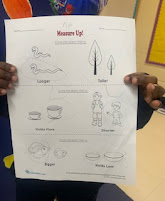Measure Up!
Personal Objective:
This lesson is created to teach Pre-kindergarten/Kindergarten students to understand measurement. Measurement is all about comparisons. Therefore students will engage in an activity where they will learn to look and two pictures and decipher between bigger, longer, shorter, more, and less.
Common Core Standard:
PK.MATH.10. [NY-PK.MD.1.] Identifies measurable attributes of objects, such as length or weight, and describes them using appropriate vocabulary (e.g., small, big, short, tall, empty, full, heavy, light)
Mathematical Practice Standards
MP4. Model with Mathematics
MP5. Use appropriate tools strategically
Materials & Preparation
- Dry Erase Board/Marker
- Measure Up Worksheet
- Pencil
Activity:
1. I will stand in the front of the classroom and using a dry erase board and marker I will draw on pictures that detail ("longer" or "shorter," "more" or "less" etc.).
2. Next, I will share with students that today we will be learning how to which is bigger or smaller and what is more or less. I will ask students what will we be learning about and they will repeat *Big, Small, More and Less.
3. I will explain to students that I will point to a set of pictures and they will look at both pictures and decipher, which is bigger, smaller, more, or less.
4. I will begin by pointing to two pictures of shapes (one bigger and the other smaller). I will ask students which is bigger/smaller. After students, answer, I will go to the next set of pictures I drew (a picture of two cups). I will ask students which do you think holds more/less. This process will be continued until all of the drawn on examples are completed. While completing this, I will also, students questions such as "How do you know this is bigger or smaller? How do we know which holds more or less? What is it a picture of?"
5.Upon doing this, students will now engage in independent instruction. Using a Measure Up Worksheet and pencil students will follow the same process of looking at the two sets of pictures. However, this time circling the object that is bigger, smaller, longer, shorter, or holds more or less.
6. As students engage in individual instruction, I will ask questions such as: What picture do we see? Is it longer/shorter, more/less, taller? etc.
Other Resources:
Book: Inch by Inch
Author: Leo Lionni
Reflection:
I chose this task because measurement is a practical skill. It is also, a skill that students should be taught because it is most often used during in real life experiences. While practicing, students will also, begin to develop the vocabulary of measurement and comparison. They will familiarize themselves with terms such as: longer, shorter, taller, bigger, smaller, wider, lighter, etc.
While students engage, I will ask open-ended questions to encourage students to answer with sentences and/or share deeper and new insights.






this was an amazing post, particularly by pairing the read aloud with it to add extra student engagement! they are learning by physically doing with the use of your worksheet. I hope to utilize this lesson in the future.
ReplyDeleteYes! I love your lessons and group activities that you create for your students. Open ended questions, higher learning thinking questions, connecting the lesson with a book. Amazing!
ReplyDelete